The Tastes of Home
For the final EuroEats article, we're traveling to Hungary, where paprika and pörkölt reign supreme. It's a land of cabbage and pickles and potatoes and pork. It's home.
Paprika

Because so much of Hungarian cuisine relies on this bright, red spice, it's only fitting that we begin with it. Hungary cannot claim to have discovered paprika's culinary benefits, but it can claim it as a foodie name-to-fame.
Paprika is a dried and ground spice from the chilies of the Capsicum annum pepper species. It is indigenous to the New World (i.e. to North and South America), so Hungarians had to wait until the early 16th century to sample this new flavor. And once they did, they never looked back. Modern Hungarians sprinkle it liberally into soups, stews, sauces, meat mixtures, marinades, and even salads, so it truly is a staple ingredient.
Kovászos Uborka

Translated as "leavened pickles", kovászos uborka is made differently than other pickles. Vinegar is omitted, and the cucumbers are instead placed into a jar with dill, garlic, water, and salt. One or two slices of bread are stacked on the bottom and top of the mixture, and the jar is left to sit in the sun for a few days to allow the yeast in the bread to speed up the fermentation process. After the bread slices are removed, one gets pickles that are (ideally) salty but not overly so, with a unique tang that vinegar simply cannot give.
Hungarians eat these pickles (and other pickled vegetables) as accompaniments to their meat-based dishes.
Lángos
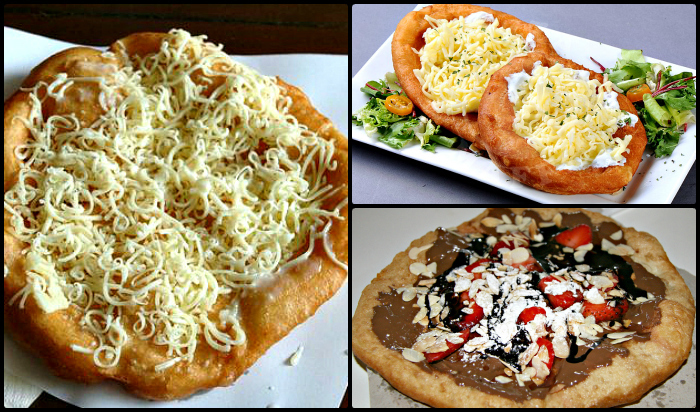
This simple yet delicious food consists of fried, yeasty dough, topped with just about anything you can imagine. Garlic, cheese, and sour cream are the accouterments that Hungarians tend to choose, and I usually get mine plain with just salt, or with a Hungarian cheese called trappista shredded on top. If you're more of a sweet-tooth, however, never fear, for you can have honey and cinnamon, sugared nuts, fruit, or even Nutella on your lángos.
Honestly, lángos is one of the things I miss most about Hungary.
Szalámi
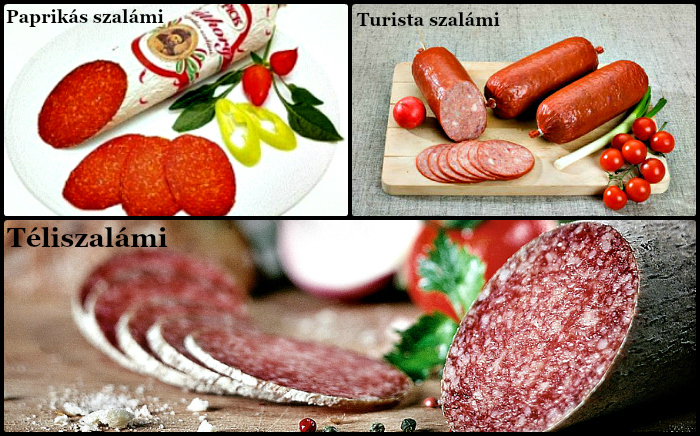
Salami, perhaps the most famous cold cut of all. One cannot write about Hungarian cuisine without mentioning salami. It is a staple in every Hungarian's diet, usually eaten on bread for breakfast and/or supper, with fresh vegetables (tomatoes, onions, peppers, or cucumbers) and maybe a cheese or two.
Téliszalami, or winter salami, is traditionally made from a special (and tasty!) breed of Hungarian pig, called the mangalica. Spices, such as white pepper and allspice, are added, and the sausage is then cured in cold air and smoked very slowly. Once the process is finished, you are left with a long cylinder of salami that has the characteristic noble mold on the outside (which you obviously do not eat). Téliszalámi is generally the salami that most people think of when Hungary is mentioned, and it is so beloved that the EU designated it as a protected food in 2007. If you are in Hungary and want to sample winter salami, I recommend the Pick brand.
Paprikás szalami is quite different from its wintery cousin. In addition to the spices that téliszalami contains, it also has hot paprika, which accounts for its rust-red color and mildly spicy flavor. Ever since I was a child, this salami has been my favorite, and it's the first food I eat when I arrive in Budapest.
The final Hungarian salami I'm going to cover is turista szalámi ("tourist's salami"). Now this salami is really different, as it somewhat resembles the Italian Genoa salami or even a vaguely bologni-like cold cut. Using the same meat as the other two (i.e., pork), turista szalámi leaves out both the mold of téliszalámi and the paprika of paprikás szalámi, for a more mild, porky flavor. Perhaps that is why they call is tourist's salami.
Palócleves
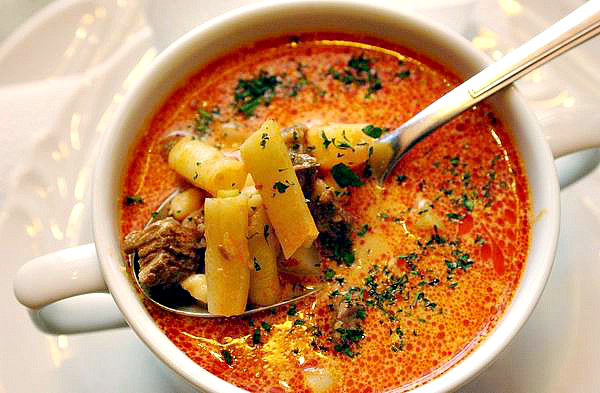
Palócleves is a hearty soup that hails from the Palóc ethnic group in northeastern Hungary and present-day southern Slovakia. Featuring green beans (or the yellow Hungarian wax beans, if you're in Hungary); chunks of meat (beef and/or lamb); kohlrabi (again, if you're in Hungary); potato; dry, spicy pork sausage; sour cream; and, yes, the ever-present paprika, this soup is one of my favorites. There are so many flavors vying for your attention, yet each one is balanced in the whole.
Káposztás Paszuly
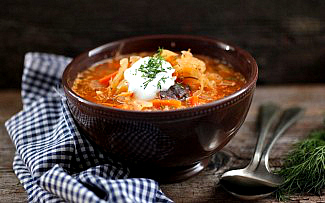
Another of my favorite soups might be a bit much for some of my readers, because it contains lots of sour cabbage (i.e. sauerkraut) and beans. Pork, usually in the form of ham hock, carrots, paprika, and sour cream are also added, but it is the beans and cabbage combination that I love most. It is tart from the cabbage and extra flavorful from the ham, while the milder beans and sour cream round out the explosion of tastes in your mouth.
Káposztás paszuly is characteristic of the cuisine of the Alföld, the plains region of southern and southeastern Hungary. And for that reason, it holds sentimental value to me, because my maternal grandmother was born there. It was also--coincidentally or not--my grandmother's favorite soup.
Húsleves
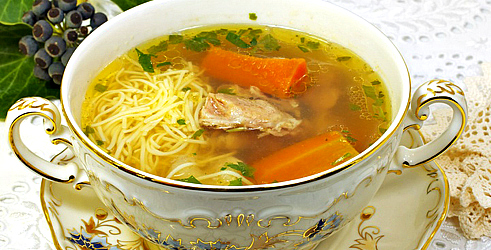
Húsleves translates to "meat soup", and this is an apt name, since it employs meat (chicken, beef, pork, or a combination) broth. There are actually two versions of this soup: restaurant and home-cooked.
If you were to order húsleves in a restaurant, you would get a clear broth with some vegetables (usually carrots and parsnips) and pasta (either the thin metélt or the tiny csipetke) floating in it. Perfectly delicious, but not very substantial.
The home-cooked version, or at least my mother's version, is much more ingredient-heavy. Large pieces of meat (beef and pork) and whole, peeled vegetables (carrots, celery, potatoes, and savoy cabbage or brussel sprouts or kohlrabi) are boiled with garlic, onion, black peppercorns, and the Croatian spice mix Vegeta thrown in for extra flavor. The meats and vegetables are eaten together, with either mustard or horseradish (or both, if you're me), like the Austrian Tafelspitz. Then the broth is strained, and the pasta is spooned into each serving.
Because my mother's húsleves contains so much vitamin C, it's the ideal food to eat if you are sick.
Főzelék

Although the previous dishes were quintessentially Hungarian, there are few foods that scream "Hungarian home cooking" like the funny főzelék. Not quite a soup, but not a stew either, this concoction consists of a vegetable (potato, savoy cabbage, green beans, peas, etc) cooked in plenty of water flavored with salt and a bay leaf. A roux of flour; fat (olive oil or lard); and onions or garlic, depending on the vegetable used, are mixed into the simple vegetable soup. Sour cream is added, again, depending on the vegetable. For example, kelkáposzta főzelék is savoy cabbage, potato, and carraway seeds, combined with a roux of garlic and paprika, while krumpli főzelék is simply potato and bay leaf, with a roux of diced onions, and sour cream stirred in.
Since this is generally not a meal in itself (unless you are me), some kind of meat is served alongside it.
Csirke Paprikás and Pörkölt
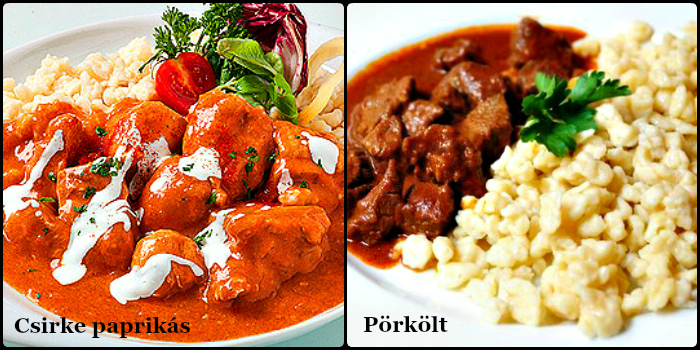
Arguably one of Hungary's most famous foods, the bright red csirke paprikás showcases chicken (csirke) and paprika (paprikás). The chicken is simmered in a puréed sauce of paprika, diced onions, peppers, and tomatoes that has been thinned out slightly with water or stock, after which it is served with dollop of sour cream alongside a starch (most commonly a Hungarian egg and flour dumpling called nokedli).
The second dish is very similar to the first, except bite-sized pieces of beef are used, instead of chicken. However, pörkölt can also be eaten with any kind of főzelék, in which case it is always served on top of the vegetable concoction.
Hortobágyi Palacsinta

Or the "Hungarian enchilada", as my nephew likes to call it. The hortobágyi palacsinta gets its name from the Hortobágy region of the Alföld, but this savory, stuffed crepe was actually created for the 1958 Brussels World Fair, probably not in the Hortobágy. No matter its origin, the hortobágyi palacsinta is delicious.
A thin, savory crepe is filled with a minced meat mixture (veal, beef, pork, or chicken) that is generously flavored with onions, paprika, peppers, and spices (like the csirke paprikás or pörkölt is) and is then baked. To serve it, a sauce of sour cream, paprika, and the same veggies that are inside the crepe is drizzled over it.
Cigánypecsenye
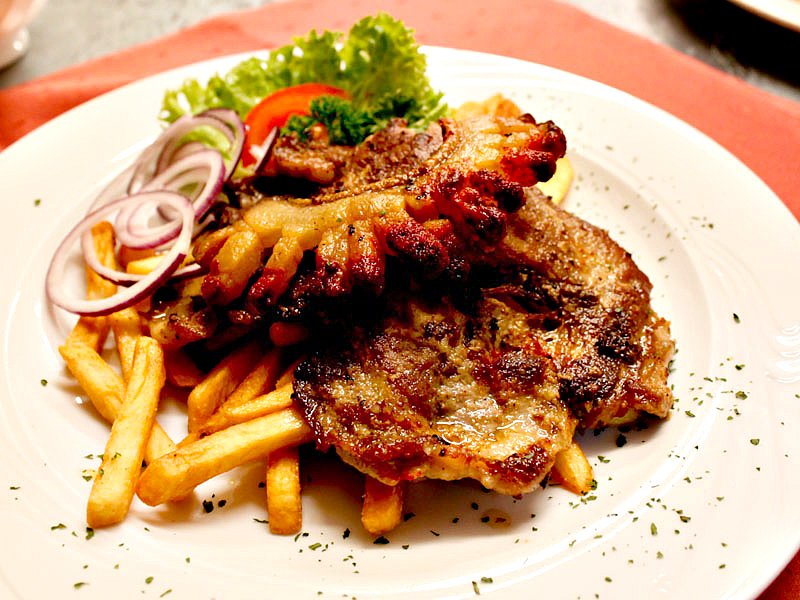
Aside from bécsi szelet (i.e., Wienerschnitzel), cigánypecsenye is probably the most common pork dish you will find on a Hungarian menu. Translated as "Gypsy roast", it consists of a thin slice of pork that is generously marinated in garlic and paprika, then is pan-fried. It is garnished with szalonna, a thick, fatty Hungarian bacon (think pork belly) and served alongside potatoes and pickled vegetables (kovászos uborka, cabbage, cucumbers, or hot cherry peppers).
Töltött Káposzta
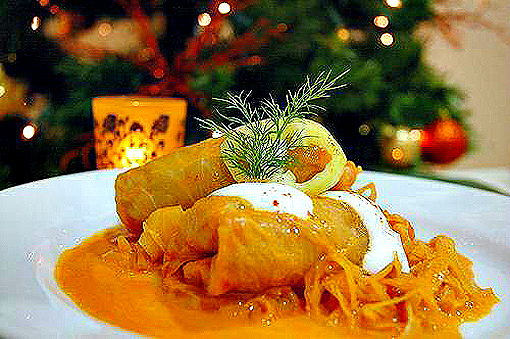
Stuffed cabbage is one of the many foods Central and Eastern Europe share, though each country (and even region!) puts its own unique spin on it. The Hungarian version I will be describing is in the Kolozsvár style, hailing from Kolozsvár (Cluj-Napoca) in present-day Romania (Transylvania).
Cabbage leaves that have been cut in half are blanched, then stuffed with a mixture of raw, ground pork; cooked rice; chopped onions; lots of black pepper; and lots of paprika. The pliable cabbage is wrapped around the filling, and the little packages are nestled into pots of a tomato purée-water solution to cook, often with a few links of Hungarian smoked sausage for extra flavor. Once finished, the töltött káposzta are traditionally topped with sour cream.
Because it is quite labor-intensive, Hungarians primarily eat stuffed cabbage on Christmas, but my family eats it on other special occasions, too (or, whenever we feel like it?).
Somlói Galuska

One of my favorite desserts is the trifle-like sponge cake from the Somló region of Hungary. Three slices of rum-soaked sponge cake (vanilla, chocolate, and walnut) are layered with a vanilla custard and chopped walnuts, then are left to sit for a few hours until the flavors meld together. Somlói galuska is served with chocolate sauce and whipped cream, and some recipes call for raisins, as well, but I leave them out. The final product may look like one, big mess, but it is so delicious.
Madártej
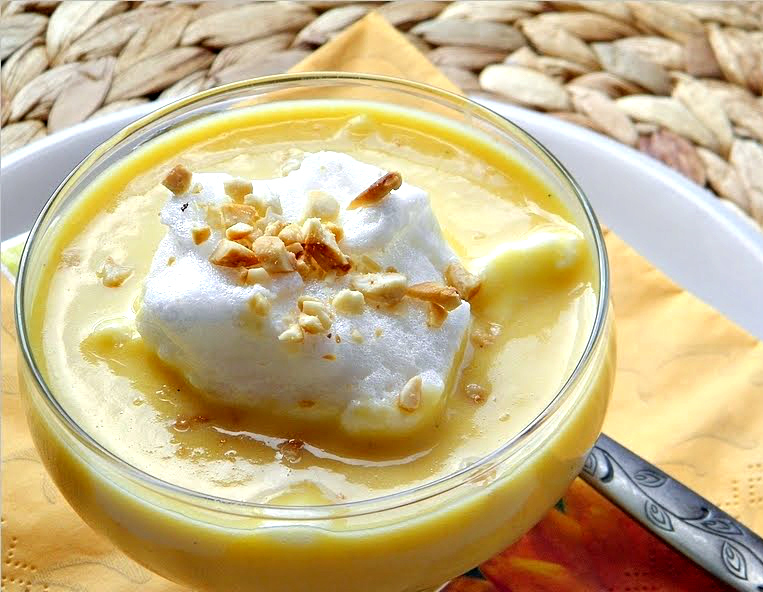
Literally, madártej translates to "bird's milk", which, to be honest, does not sound appetizing at all. But fear not, it's merely the Hungarian version of the French île flottante, or floating islands. This dessert got that name from the little dollops of meringue floating in a sea of crème anglaise (vanilla custard).
Now for some etymology. The name madártej ("bird's milk") comes from a pun dating back thousands of years, in reference to a food that was nearly impossible to come by (since, y'know, birds don't actually produce milk...). Apparently this dessert was so rare in Hungary at one point that the people began calling it madártej, instead of its proper French name, and the moniker simply stuck.
Dobos Torta

The final food in this article is a famous Hungarian dessert called Dobos torta ("Dobos cake"), named after its creator, József C. Dobos, in which five slices of sponge cake are layered with chocolate buttercream and are topped with caramel and nuts. This cake may sound familiar to some of you, as the German version, the Prinzeregententorte, is quite similar.






